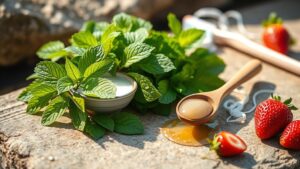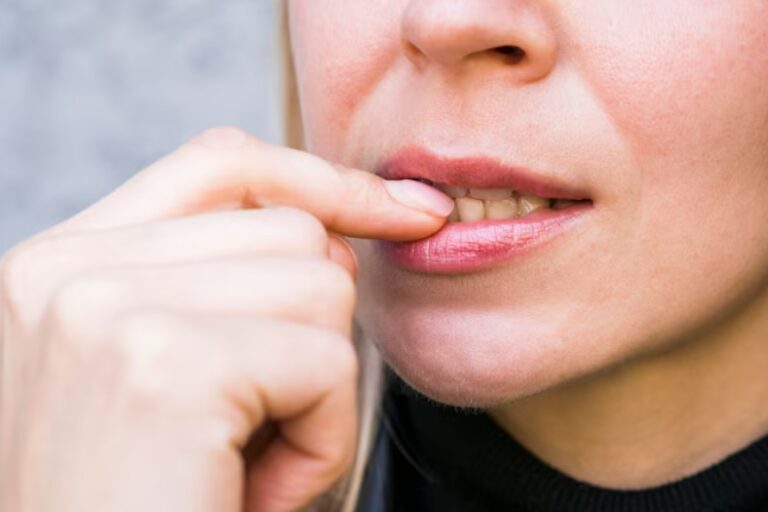Ever ponder why plaque seems to cling to your teeth like a stubborn buddy that just won’t leave? It’s a common issue, but the encouraging update is you don’t always need harsh chemicals to tackle it. There are several dentist-approved home remedies that can help keep your teeth clean and healthy. From oil pulling to crunchy snacks, these natural methods are not only effective but also gentle on your mouth. Want to uncover how to make plaque a thing of the past?
Plaque and Tartar Buildup
Whenever you munch on sugary or starchy snacks, you’re not just satisfying your taste budsyou’re also inviting a sticky foe to your dental party. That foe, called plaque, forms on your teeth within 4 to 12 hours post-snack.
In case you don’t brush it away within 48 hours, it hardens into tartar, which clings tightly to your enamel. This gritty build-up doesn’t just annoy your gums; it also traps bacteria, increasing your risk for tooth decay.
As plaque produces acids, it lowers the pH in your mouth, damaging your precious enamel. The encouraging update? Sticking to a solid oral hygiene routine with regular brushing and flossing can help remove up to 70% of plaque, keeping your smile happy and healthy!
Baking Soda: A Natural Scrub for Teeth
Using baking soda can truly be a game changer in your oral care routine. This natural scrub effectively removes plaque and surface stains without harming your tooth enamel if used sparingly. Its mild abrasiveness helps you brush away gunk, while studies show that baking soda can reduce plaque up to 60% more than regular toothpaste.
Thanks to its alkaline pH of 8.3, it neutralizes harmful acids produced through oral bacteria, slowing plaque formation. To create your own paste, simply mix 1 teaspoon of baking soda with 2 teaspoons of water.
Just keep in mind, while baking soda is effective, overuse—more than 2–3 times a week—can erode your enamel, so balance is key.
Oil Pulling: Ancient Technique for Oral Health
Have you ever heard of oil pulling?
This ancient practice might be just what you need to enhance your oral health and combat plaque.
Through swishing oil in your mouth, you’re tapping into a natural technique that can make a real difference whenever you stick with it!
Benefits of Oil Pulling
Should you be looking for a natural way to boost your oral health, oil pulling could just be the solution you’ve been seeking. This ancient practice involves swishing oil, like coconut, in your mouth for 15–20 minutes.
Research shows that oil pulling with coconut oil helps prevent plaque through decreasing harmful bacteria such as *Streptococcus mutans*. The lauric acid in coconut oil has antimicrobial properties that dismantle that sticky film of bacteria, ultimately improving your oral hygiene.
Plus, this method can reduce plaque by up to 20% and gingivitis by 50%! It also freshens your breath through eliminating odor-causing bacteria.
Gentle and effective, oil pulling can even help whiten your teeth naturally over time.
How to Practice
Oil pulling isn’t just a fascinating ancient technique; it’s also incredibly easy to incorporate into your daily routine. To get started, follow these simple steps:
| Step | Action | Details |
|---|---|---|
| 1 | Choose your oil | Coconut, sesame, or sunflower |
| 2 | Swish the oil | 1 tablespoon for 15-20 minutes |
| 3 | Do it on an empty stomach | Helps maximize benefits |
| 4 | Spit it out | Don’t swallow to avoid toxins |
This daily practice can help remove plaque and prevent tartar, thanks to the antibacterial properties of coconut oil. Just keep in mind, oil pulling doesn’t replace brushing and flossing; it’s a supportive home remedy for healthier teeth and better oral hygiene.
Apple Cider Vinegar: A Natural Mouthwash
Apple cider vinegar can be a powerful ally in your fight against plaque as used as a mouthwash.
To maximize its benefits, you’ll want to dilute it properly and swish the mixture for a solid 30 seconds or so.
Just keep in mind, while it helps dissolve plaque, it shouldn’t replace regular brushing and flossing.
How It Works
Using a natural mouthwash can be a game changer for your oral health, particularly as it pertains to plaque removal. Apple cider vinegar is your secret weapon, dissolving tartar and killing harmful oral bacteria. Just keep in mind to dilute it—using it straight could lead to enamel erosion.
Here’s a quick overview:
| Benefit | How It Works | Key Reminder |
|---|---|---|
| Remove plaque | Acetic acid fights plaque | Always dilute to protect enamel |
| Dissolve tartar | Swishing dislodges buildup | Use a 1:2 ratio of vinegar to water |
| Kill harmful bacteria | Reduces oral bacteria levels | Avoid undiluted vinegar |
| Whiten teeth | Removes surface stains | Swish for at least 30 seconds |
| Maintain oral health | Promotes gum health | Rinse daily for best results |
Try it out and watch your smile shine!
Proper Dilution Ratios
While many seek quick fixes for oral health, grasping proper dilution ratios for apple cider vinegar is key to maximizing its benefits without compromising your enamel.
Here’s how to create a safe, effective mouthwash:
- Mix 1 part apple cider vinegar with 2 parts water.
- Use 1 tablespoon of vinegar with 2 tablespoons of water for a diluted solution.
- Swish gently for no longer than 30 seconds to avoid enamel erosion.
- Rinse with water afterward to neutralize residual acidity.
Frequency of Use
Finding the right frequency to use apple cider vinegar as a mouthwash can significantly impact your oral health. You can safely incorporate it into your routine by mixing it with water at a 1:2 ratio.
While you could believe daily use sounds beneficial, it’s best to limit it to 1–2 times per week to protect your enamel. On other days, stick to brushing twice daily with fluoride and daily flossing to maintain a healthy mouth.
Swish the diluted mixture for just 30–60 seconds, then rinse with plain water to neutralize acidity. Don’t use undiluted vinegar, as it can cause sensitivity.
With consistent use over a month, you could observe reduced plaque, but stop should you experience any irritation!
Crunchy Fruits and Vegetables: Nature’s Toothbrushes
At the time it comes to maintaining a healthy smile, crunching on a few fruits and veggies can do marvels for your teeth. These crunchy delights help remove plaque, stimulate saliva production, and keep your gums strong.
Try including these items into your diet:
- Apples – They scrub away plaque buildup and can reduce it up to 20% if eaten raw.
- Carrots – These crunchy veggies stimulate saliva, washing away food particles and neutralizing acids.
- Celery – Its fibrous texture acts as a natural abrasive, polishing tooth surfaces as you chew.
- Bell Peppers – Loaded with vitamin C, they strengthen gums, making them more resistant to inflammation.
Enjoy munching your way to healthier teeth!
Chewing Sesame Seeds: A Crunchy Solution
Should you be seeking a natural method to boost your dental health, consider adding sesame seeds in your routine. Chewing sesame seeds acts as a natural abrasive, effectively scrubbing away plaque and tartar buildup from your teeth.
With every bite, these seeds release oil that forms a protective layer, reducing bacterial adhesion and helping to remove plaque and food particles. Plus, they’re packed with calcium, which strengthens your tooth enamel and combats plaque-causing bacteria.
Studies show that chewing for just 5–10 minutes can reduce plaque up to 20%! For best results, try including this delicious habit into your schedule 2–3 times a week to keep your smile bright and healthy.
Aloe Vera: Soothing Gum Care
While you might consider aloe vera as merely a calming treatment for sunburns, this extraordinary plant also performs miracles for your gum health. Its antibacterial properties make it a must-have in your oral care toolkit.
Here are some ways you can use aloe vera gel for soothing gum care:
- Reduce plaque build-up: Aloe vera can cut plaque-causing bacteria through up to 50%.
- Soothing gum inflammation: Applying aloe vera gel supports healing from inflammation and bleeding.
- Fight oral pathogens: Its compounds combat the bacterial biofilm that leads to gum disease.
- Mouthwash alternative: Studies show aloe vera mouthwash is as effective as chlorhexidine without staining your teeth.
Incorporate aloe vera into your routine, and watch your gum health improve naturally!




